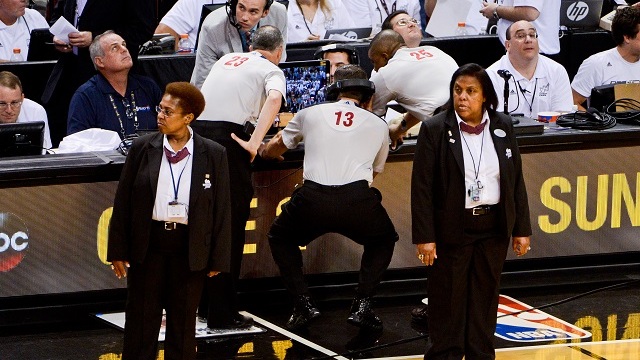
It was almost one of the great moments of March Madness this year.
On Friday afternoon, Loyola (Chi) began it’s miracle run to the Sweet 16 with a 64-62 victory over Miami. It was a classic March ending, with Miami missing a free throw that could have helped ice the game, Loyola getting the rebound, coming down the court, and Donte Ingram swishing a three-pointer just before the final buzzer.
It was a fantastic moment, quintessential March.
Except … Until.
The referees huddled around the monitor. They checked the time. They checked it again. They made sure that the clock was correct. They added .3 of a second back on the clock. Enough time for a theoretical basket, but in practice, the game was over.
Then, a Miami timeout.
Then, a Loyola timeout.
Finally, the final “possession” happened, and Loyola finally won the game it had won a few minutes earlier.
So a thrilling buzzer beater, the kind of moment that makes March so wonderfully mad, was neutered by instant replay. Because we had to get the call right.
Instant replay reviews became a bit of a talking point over the first weekend of the NCAA men’s tournament. The final minute of the Witchita State-Marshall game was took 18 minutes of real time to play because of a series of replay reviews.
From a fan perspective, instant replay has become maddening. Joe Posnanski has written about this for years, about how when a scoring play happens, we all get excited – but only halfway, because we have to make sure the review confirms the play, and then we can celebrate, but by that point, the moment has passed. It’s kind of like the end of the Loyola-Miami game. The excitement of the victory got tempered. Instead of the dramatic moment and the buzzer-beater, we had a long replay review (plus timeouts) and a weird throw-in play to end it.
Was it the right thing to do?
Probably?
But it sure wasn’t a fun way to end the game.
Why do we have instant replay?
Take a second and ask yourself that. Why do we have replay in sports? Why is it there?
Is it to correct mistakes? Or is it to get the calls right?
Those sound like the same thing, but they’re not.
I have no data to back this up (which is always a bad sign for an argument, I know), but my hunch is that most people would say that we have replay to get the calls right, but what they really mean is to correct the egregious mistakes. The Larry Dierker/James Joyce-level mistakes. The calls that are clearly wrong that we can see on replay and easily fix.
That’s not how replay is used. Replay is used to judge everything down to the micrometer. It’s led to the NFL’s catch rule controversy, the toe-drag offsides calls in the NHL, the plays at second base when a sliding runner’s hand pops off the bag by a millimeter for a split second.
Technically, all of those calls are now correct.
But is that the spirit of the game?
Is it worth it?
Is getting these calls right worth sucking so much energy and excitement and fun out of our games?
Thing is, there’s no going back to a time before replay. There’s no way. With the improvements in media technology, there’s no way we can rely on human beings making judgement calls in real time. There’s no way a home audience should have a better view of the game than the officials.
But maybe there’s a way we can speed up the review process. Maybe technology can be the answer, with more automated calls and measurements and timing systems.
Maybe, we can still get the calls right without sucking the fun out of sports.
Dr. Brian Moritz, also known as the Sports Media Guy, is an assistant professor at SUNY-Oswego. For more of Brian’s work, check out his website at https://www.sportsmediaguy.com/


